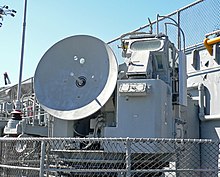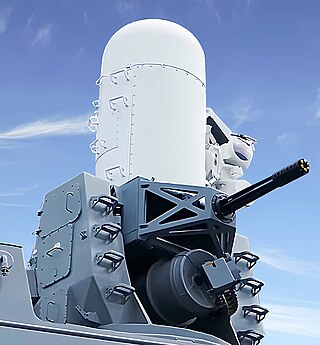
The Phalanx CIWS is an automated gun-based close-in weapon system to defend military watercraft automatically against incoming threats such as aircraft, missiles, and small boats. It was designed and manufactured by the General Dynamics Corporation, Pomona Division, later a part of Raytheon. Consisting of a radar-guided 20 mm (0.8 in) Vulcan cannon mounted on a swiveling base, the Phalanx has been used by the United States Navy and the naval forces of 15 other countries. The U.S. Navy deploys it on every class of surface combat ship, except the Zumwalt-class destroyer and San Antonio-class amphibious transport dock. Other users include the British Royal Navy, the Royal Australian Navy, the Royal New Zealand Navy, the Royal Canadian Navy, and the U.S. Coast Guard.

An anti-ship missile (AShM) is a guided missile that is designed for use against ships and large boats. Most anti-ship missiles are of the sea skimming variety, and many use a combination of inertial guidance and active radar homing. A large number of other anti-ship missiles use infrared homing to follow the heat that is emitted by a ship; it is also possible for anti-ship missiles to be guided by radio command all the way.
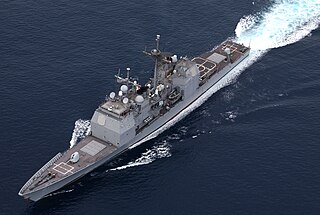
The Aegis Combat System is an American integrated naval weapons system, which uses computers and radars to track and guide weapons to destroy enemy targets. It was developed by the Missile and Surface Radar Division of RCA, and it is now produced by Lockheed Martin.

The AN/SPG-51 is an American tracking / illumination fire-control radar for RIM-24 Tartar and RIM-66 Standard missiles. It is used for target tracking and Surface-to-air missile guidance as part of the Mk. 73 gun and missile director system, which is part of the Tartar Guided Missile Fire Control System.
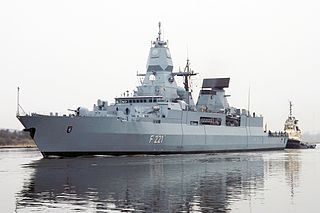
The F124 Sachsen class is the German Navy's latest class of highly advanced air-defense frigates. The design of the Sachsen-class frigate is based on that of the F123 Brandenburg class but with enhanced stealth features designed to deceive an opponent's radar and acoustic sensors. The class incorporates an advanced multifunction radar APAR and a SMART-L long-range radar which is purported to be capable of detecting stealth aircraft and stealth missiles.

The Tartar Guided Missile Fire Control System is an air defense system developed by the United States Navy to defend warships from air attack. Since its introduction the system has been improved and sold to several United States allies.

The 5" /54 caliber lightweight gun is a U.S. naval artillery gun mount consisting of a 5 in (127 mm) L54 Mark 19 gun on the Mark 45 mount. It was designed and built by United Defense, a company later acquired by BAE Systems Land & Armaments, which continued manufacture.

The four De Zeven Provinciën-class frigates are air-defence and command frigates in service with the Royal Netherlands Navy. This class of ships is also known as "LCF". The ships are similar to the German Sachsen-class frigates in role and mission.

The AN/SPG-55 was an American tracking / illumination radar for Terrier and RIM-67 Standard missiles (SM-1ER/SM-2ER). It was used for target tracking and surface-to-air missile guidance as part of the Mk 76 missile fire control system. It was controlled by a UNIVAC 1218 computer.
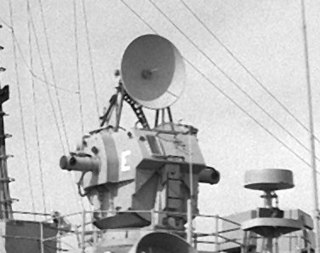
The AN/SPG-53 was a United States Navy Gun Fire-control radar, used in conjunction with the Mark 68 gun fire-control system.

The Iowa-class battleships are the most heavily armed warships the United States Navy has ever put to sea, due to the continual development of their onboard weaponry. The first Iowa-class ship was laid down in June 1940; in their World War II configuration, each of the Iowa-class battleships had a main battery of 16-inch (406 mm) guns that could hit targets nearly 20 statute miles (32 km) away with a variety of artillery shells designed for anti-ship or bombardment work. The secondary battery of 5-inch (127 mm) guns could hit targets nearly 9 statute miles (14 km) away with solid projectiles or proximity fuzed shells, and was effective in an anti-aircraft role as well. Each of the four battleships carried a wide array of 20 mm and 40 mm anti-aircraft guns for defense against enemy aircraft.
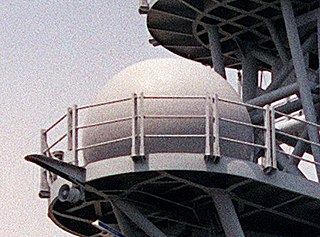
AN/SPQ-9A,, is a United States Navy multi-purpose surface search and fire control radar used with the Mk-86 gun fire-control system. It is a two dimensional surface-search radar, meaning it provides only range and bearing but not elevation. It is intended primarily to detect and track targets at sea level, on the surface of the water for either gun fire engagement or navigation. It can however, also detect and track low altitude air targets.

Ship gun fire-control systems (GFCS) are analogue fire-control systems that were used aboard naval warships prior to modern electronic computerized systems, to control targeting of guns against surface ships, aircraft, and shore targets, with either optical or radar sighting. Most US ships that are destroyers or larger employed gun fire-control systems for 5-inch (127 mm) and larger guns, up to battleships, such as Iowa class.

The AN/SPY-1 is a United States Navy 3D radar system manufactured by Lockheed Martin. The array is a passive electronically scanned system and a key component of the Aegis Combat System. The system is computer controlled and uses four complementary antennas to provide 360-degree coverage. The system was first installed in 1973 on USS Norton Sound and entered active service in 1983 as the SPY-1A on USS Ticonderoga. The -1A was installed on ships up to CG-58, with the -1B upgrade first installed on USS Princeton in 1986. The upgraded -1B(V) was retrofitted to existing ships from CG-59 up to the last, USS Port Royal.

The Mark 34 Gun Weapon System (GWS) is a component of the Aegis Combat System that is responsible for controlling and providing fire control to the 5" Mark 45 gun. It is used on the U.S. Navy Arleigh Burke-class destroyer and several later Ticonderoga-class cruisers. The Mk 34 GWS receives target data from the ship's sensors and off-ship sources, performs ballistic calculations, and produces gun control orders. The system is made up of the gun mount itself, the fire-control computer, and an optical sight.
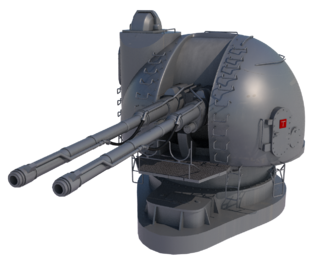
The AK-130 is a Russian designed automatic dual barrel naval cannon with a caliber of 130 millimetres (5.1 in), capable of firing 10-40 rounds per minute.

The AN/SPG-60 is a United States tracking radar that is part of the MK-86 Gun Fire Control System (GFCS). It is used for air tracking and on some MK-86 configurations it is also used for illumination for RIM-24 Tartar and RIM-66 Standard missiles. Though the radar is primarily an air tracking radar, the SPG-60 radar can be used for surface tracking. With the boresight mounted camera, the radar could also be used as a sight for optical tracking, optical engagement and damage assessment.

OPS-28 is a Pulse-Doppler radar manufactured by Japan Radio. It is installed as a low-altitude warning / anti-water search radar mainly on the Maritime Self-Defense Force's escort ship. Variations include OPS-28-1, OPS-28B, OPS-28C, OPS-28D, OPS-28E and OPS-28F.

AN/SPS-10 is a two-dimensional radar manufactured by Raytheon Technologies. It was used by the US Navy as a surface-search radar after World War II and was equipped aboard naval ships during the Cold War. Variants include AN/SPS-10B, AN-SPS/10E, and AN/SPS-10F.

Mark 63 Gun Fire Control System is a gun fire-control system made up of AN/SPG-34 radar tracker and the Mark 29 gun sight. They were usually equipped for the control of twin QF 4-inch naval gun Mk XVI and Mk.33 twin 3"/50 cal guns.
